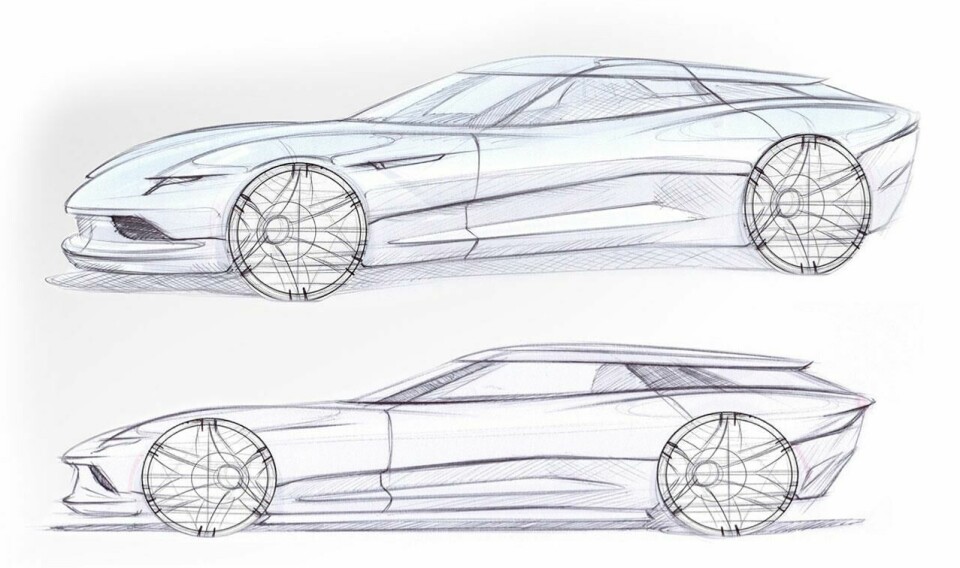
Q&A: Matt Humphries on the Alcraft GT
We quizzed the ex-Morgan designer on his part in the crowdfunded British electric shooting brake
How long did it take to reach the stage you’re at now?
We started the project back in February/March 2015 and then had a virtual design (including the engineering) by the end of Q4 2015. We then showed this to private clients at this stage. The final design (including model) was finished in early 2016.
How big is the design team?
I worked with MHD partners in Alias to develop the project, but the main bulk of the design was produced by myself.
What’s the studio setup like? Is it based at Silverstone where the car was engineered?
We did a large amount of the work at Silverstone and then some in my private studio.
How much is left to do design-wise at this stage?
We have completed all exterior and interior A-surfaces but still have some B-surface engineering and detail design to complete. There will of course be a lot more production design to be produced as we go through production design stage.

Thinking about the design philosophy, how does the car we can see in images at this stage encompass “the timeless vales of British design?” What were the inspirations behind this design language?
We have tried to capture classic British design cues, keeping the design language understated. Lots of inspiration came from elegant British vehicles of the past, but we wanted to look forward and consider what modern British design stands for.
We achieved this by keeping the surface language clean, with pronounced edges and uncluttered detailing. We then let the volume and dramatic proportions do the work. The wrap-around screen with minimal A-post was one of the guiding factors that pushed the design language and proportion of the car.

You were recently at British icon Morgan, which has a classical aesthetic very much restrained by tradition – even the all-new Aero cars still had fenders like running boards and upright windscreens – so being given a clean sheet for an all-new EV must have been a very different prospect. How did you approach this brief?
Even though the classic Morgans had more traditional elements, whilst I was at Morgan we did push the design language forward when we produced the Eva GT concept car (above) for Pebble Beach. In some ways, some of the same values have been taken forward into the Alcraft project, such as exposing internal structures and engineering detail.
The philosophy of the project is different. EVs look forward to a more responsible world and customer and we wanted to capture the idea of responsible luxury. We considered this in the materials and processes we have used in the vehicle. If leather is used, it is used sparingly and is more of a jewel-like feature internally than a given quality throughout the cabin. This isn’t to say the cabin is sparse, with exposed structures being to an ‘A’ surface quality, but it is considered and responsible in its choices.

How soon was the two-box shape defined as being a core part of the car? Was there a lot of exploration first?
We did a lot of benchmarking of existing vehicles at the start of the design process – analysing the potential customer and niches in the market. As we identified that the consumer wanted practicality with elegance, it was decided that the shooting brake was the chosen direction. From this, and considering EV packaging, the volume and proportion was established.
How much did you take into account the electric powertrain? Was it central to defining shapes, proportions and features, or was it more a case of fitting batteries and motors into a predefined form (for instance, is the boot floor quite high because of a large motor or battery underneath, or was it a design decision? Are the skinny grilles functional, or aesthetic touches)?
The electric powertrain does make for a flexible design process. We needed to make sure the batteries are as low and central as possible and then package things around this. We also had to keep the batteries low and central to ensure a well-balanced car.

What are the approximate dimensions? Is it more compact than the vast Ferrari shooting brakes and if so, would a 2+2 version (mentioned as a possibility) require a longer wheelbase?
We have a similar wheelbase to an BMW i8 but have slightly longer overhangs. It’s not a large car but with clever packaging we should be able to make the vehicle a 2+2 without changing the wheelbase. We are closer to a Jaguar F-Type in scale than a Ferrari FF. The car is nearly as wide as a Model S.
Is the ‘shooting brake’ a body style that you personally enjoy, and why?
Yes, personally I have always found shooting brakes rather charming. There is something rather special and romantic about them – I suppose because most were coach built for exotic clients. I also think the proportions and volumes of a shooting brake can work better than a coupé. Being able to take the roofline all the way to the rear helps to shift the visual weight back as well. Having a little more visible weight over the rear wheels also makes the car look planted to the road.

1972 Ferrari 365 GTB/4 Shooting Brake by Panther Westwinds
The Daytona shooting brake, with coachwork by Panther Westwinds is a favourite of mine. Its odd volumes are wrong, but just look correct and this makes it plain cool.



